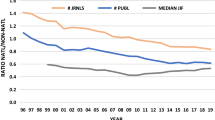Abstract
Several scientometric indicators of 29 countries were analysed according to main scientific fields (Life, Natural, Applied, and Agricultural Sciences). The difference of the individual countries from the world average in the number of journal papers devoted to the main scientific fields was related to the GDP/capita index of the countries. Four types of research structure could be distinguished by a cluster analysis: countries preferring Life Sciences with higher or lower share in Natural Sciences, and countries preferring Natural Sciences with higher or lower share in Life Sciences. From the results it concludes, the development of a country (measured as GDP/capita) strongly influences but, it does not determine the structure of science by research fields in the country. The number of journal papers in a country classified as top cited (i.e. they belong to the 1% of papers most frequently cited in WoS ESI) was related to the total number of papers published by the country. The so obtained Top paper rate index (TPR) may represent the contribution of countries to the advance of science. Analysis of the TPR indicator of a country by research fields (i.e. Chemistry, Clinical Medicine, Space Science, etc.) may indicate strengths and weaknesses of the research on national level. Relating the Relative field citedness indicator (RW) of a country to the corresponding TPR value, conclusions may be drawn as to the homogeneity of impact of research within a country by fields.


Similar content being viewed by others
References
Aksnes, D. W., Van Leeuwen, T. N., & Sivertsen, G. (2014). The effect of booming countries on changes in the Relative Specialization Index (RSI) on country level. Scientometrics, 101(2), 1391–1401.
Albarrán, P., Perianes-Rodríguez, A., & Ruiz-Castillo, J. (2015). Differences in citation impact across countries. Journal of the Association for Information Science and Technology, 66(3), 512–525.
Cimini, G., Gabrielli, A., & Labini, F. S. (2014). The scientific competitiveness of nations. PLoS ONE, 9(12), e113470. https://doi.org/10.1371/journal.pone.0113470.
Egghe, L. (2006). Theory and practise of the g-index. Scientometrics, 69(1), 131–152.
Frame, J. D. (1977). Mainstream research in Latin America and the Caribean. Intersciencia, 2(3), 143–148.
Garfield, E. (1976). Significant journals of science. Nature, 264(5587), 609–615.
Garfield, E. (2006). The history and meaning of the Journal Impact Factor. JAMA, 295(1), 90–93.
Garfield, E., & Share, I. H. (1963). New factors in evaluation of scientific literature through citation indexing. American Documentation, 14(3), 195–201.
Glänzel, W. (2000). Science in Scandinavia: A bibliometric approach. Scientometrics, 48(29), 121–150.
Glänzel, W., Schubert, A., & Braun, T. (2002). A relational charting approach to the world of basic research in twelve science fields at the end of the second millennium. Scientometrics, 55(3), 335–348.
Hatemi-J, A., Ajmi, A. N., Montasser, G. E., Inglesi-Lotz, R., & Gupta, R. (2016). Research output and economic growth in G7 countries: New evidence from asymmetric panel causality testing. Applied Economics, 48(24), 2301–2308.
Hirsch, J. E. (2005). An index to quantify an individual’s scientific research output. Proceedings of the National Academy of Sciences of the United States of America, 102, 16569–16572.
Jurajda, S., Kozubek, S., Münich, D., & Škoda, S. (2017). Scientific publication performance in post-communist countries: still lagging far behind. Scientometrics, 112(1), 315–328.
King, D. A. (2004). The scientific impact of nations. Nature, 430(6997), 311–316.
Leydesdorff, L., & Wagner, C. S. (2014). The European Union, China, and the United States in the top-1% and top-10% layers of most frequently cited publications: Competition and collaborations. Journal of Informetrics, 8(3), 606–614.
May, R. M. (1997). The scientific wealth of nations. Science, 275(5301), 793–796.
Schubert, A., Glänzel, W., & Braun, T. (1989). Scientometric datafiles. A comprehensive set of indicators on 2649 journals and 96 countries in all major science fields and subfields 1981-1985. Scientometrics, 16(1–6), 3–478.
Vinkler, P. (1997). Relation of relative scientometric impact indicators. The Relative Publication Strategy index. Scientometrics, 40(1), 163–169.
Vinkler, P. (2000). Publication velocity, publication growth and impact factor: An empirical model. In B. Cronin & H. B. Atkins (Eds.), The web of knowledge A Festschrift in honour of Eugene Garfield (pp. 163–176). Medford, NJ: Information Today Inc.
Vinkler, P. (2001). An attempt for defining some basic categories of scientometrics and classifying indicators of evaluative scientometrics. Scientometrics, 50(3), 539–544.
Vinkler, P. (2003). Relation of relative scientometric indicators. Scientometrics, 58(3), 687–694.
Vinkler, P. (2004). Characterization of the impact of sets of scientific papers: The Garfield (impact) factor. Journal of the American Society for Information Science and Technology, 55(5), 431–455.
Vinkler, P. (2008). Correlation between the structure of scientific research, scientometric indicators and GDP in EU and non-EU countries. Scientometrics, 74(2), 237–254.
Vinkler, P. (2009). The π-index. A new indicator for assessing scientific impact. Journal of Information Science, 35(5), 602–612.
Vinkler, P. (2012). The case of scientometricians with the “absolute relative” impact indicator. Journal of Informetrics, 6(2), 254–264.
Vinkler, P. (2017). The size and impact of the elite set of publications in scientometric assessments. Scientometrics, 110(1), 163–177.
Author information
Authors and Affiliations
Corresponding author
Rights and permissions
About this article
Cite this article
Vinkler, P. Structure of the scientific research and science policy. Scientometrics 114, 737–756 (2018). https://doi.org/10.1007/s11192-017-2568-7
Received:
Published:
Issue Date:
DOI: https://doi.org/10.1007/s11192-017-2568-7




